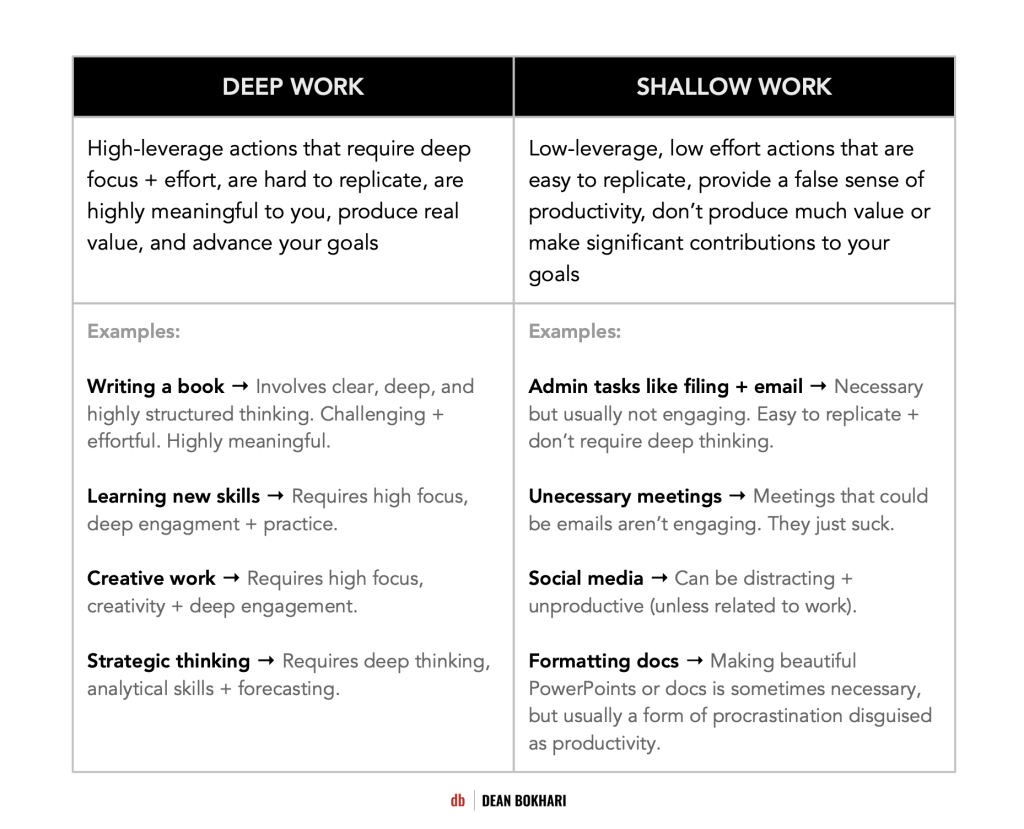1. Deep Work vs Shallow Work
Let’s start by clarifying exactly what deep work is…
Deep Work is any professional activity or work that’s performed in a state of distraction-free concentration that pushes your cognitive capabilities to their limit.
When we immerse ourselves in deep work, we’re able to:
- produce high-value work,
- improve our skills, and
- create something that’s hard to replicate
So, if you want to wring every last drop of value out of your current intellectual capacity, deep work is a necessity.
- Deep work is when a writer’s ideas just flow and their writing is clear, creative, and crisp.
- Deep work is when an entrepreneur can make profitable business decisions and focus on long-term execution with ease and effectiveness.
- Deep work is when a consultant can analyze market conditions, develop long-term plans, and forecast future scenarios like a boss.
- Deep work is when a doctor can diagnose complex cases, research and find the right treatment options, and perform intricate procedures with precision.
Doing deep work on a regular basis gives you the ability to stretch your cognitive capabilities to their limit.
It improves your skills.
And it results in something valuable that’s hard to replicate.
The opposite of Deep Work is Shallow Work…
Shallow Work is non-cognitively demanding work that’s often performed while distracted.
When we’re lost in shallow work, we don’t create much (if any) new value in the world, and what we do create is easy to replicate.
Shallow work is when we replace deep work with its shallow cousin—constantly sending and receiving e-mails punctuated with frequent breaks for quick hits of distraction… No bueno.
Take a look at the table below to get a better understanding of the differences between deep and shallow work – and what kinds of activities that fall under each:

Actionable insights
As a first step to bringing more focus and productivity into your life, start by diagnosing how much time you’re spending in Deep Work vs Shallow Work.
Here’s how:
- Take five minutes to think about what your own Deep Work vs. Shallow Work ratio currently looks like.
- Then, grab a sheet of paper and draw a line down the middle to form two columns. Label the left column “Shallow Work” and label the right one “Deep Work.”
- Next, starting with the Shallow Work column, create a list of everything you do that falls under that category. Then do the same thing for the Deep Work column.
- Once you’re done, you should have a good idea of how much time you’re spending in deep work as compared to the shallows.
Ultimately, your goal is to spend more time immersed in deep work and less time doing shallow work. This doesn’t mean eliminating shallow work altogether—it just means limiting the amount of time you spend in the shallows so you can focus your efforts on producing real value.
Ready to go Deep?
If you enjoyed this free sample lesson, then you’ll love the full version of the Deep Work course.

